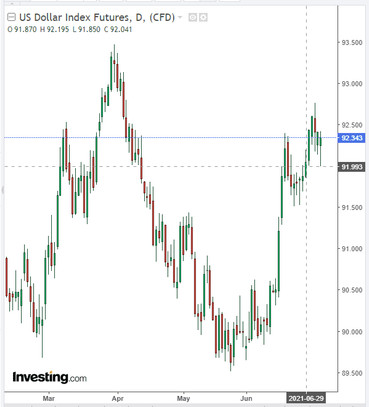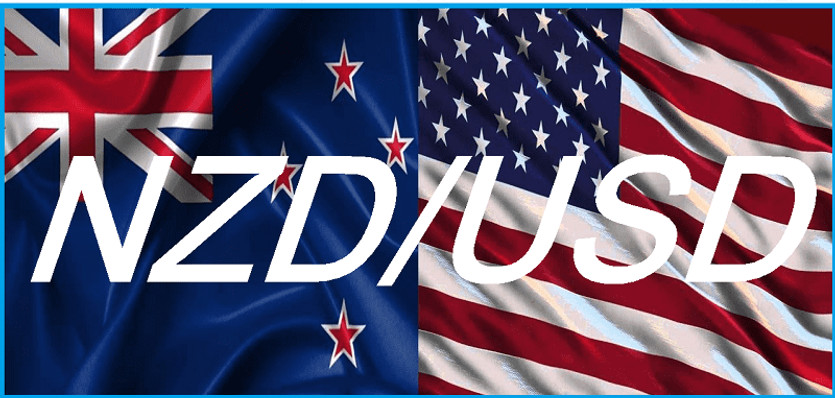On Monday, American banks and stock exchanges were closed to celebrate Independence Day. The publication of important macro statistics was also not planned. In the Asian session on Tuesday, the US dollar fell slightly on the propensity of investors to sell it after the publication at the end of last week of a controversial report on the labor market.
Data from the US Department of Labor show that hiring is accelerating as the economy continues to open up. However, these data do not signal that the Fed is faced with the need to start curtailing its stimulus policy in the near future. The number of jobs in the nonfarm sector of the US economy in June increased by 850,000, however, the unemployment rate unexpectedly rose to 5.9% from 5.8% in May. The July report of the Ministry of Labor (with data for June) testifies in favor of maintaining the Fed's wait-and-see position, which will contribute to further growth in stock indices and restrain the dollar from excessive strengthening.
This creates preconditions for the growth of quotations of commodities and, accordingly, commodity currencies, in particular, such as the Australian and New Zealand dollars. Thus, the AUD / USD pair today rose by almost 1% after the RBA meeting ended in the morning (the bank's management announced that it would begin to curtail purchases of government bonds in September, taking into account a stronger than expected economic recovery), and the NZD / USD pair - by 1.2%, to 0.7105 mark, today's and the last 14 trading days highs, again breaking into the bull market.
Additional support for the New Zealand dollar on Tuesday was provided by the published (Monday evening (at 22:00 GMT) or in the morning local New Zealand time) statistics from New Zealand: the business confidence index from NZIER in the 2nd quarter of this year increased by +7% after a decrease of -13% (qoq) in the 1st quarter.
However, at the start of today's European session, the DXY is rising again after declining during the Asian session. DXY futures are traded close to 92.34 mark as of this writing, 34 pips above today's Asian session low.

Investors' attention is now shifting to the publication on Wednesday (at 18:00 GMT) of the minutes from the June Fed meeting, the very meeting at which the central bank's management signaled the possibility of an earlier start of the phase of curtailing the stimulus policy.
As you know, following the results of the 2-day meeting on monetary policy, which ended on June 16, the Fed leaders kept key interest rates in the range of 0.00% -0.25%, and the volume of the QE asset purchase program - at the previous level of $ 120 billion per month.
The accompanying statement said that the Fed will continue to adhere to the current parameters of monetary policy until the target levels for inflation and maximum employment are reached, reiterating that the level of interest rates will not change.
At a press conference following the meeting of the Committee on Open Market Operations, Federal Reserve Chairman Jerome Powell did not say when the curtailment of asset purchases could begin, reiterating that the Fed will warn about any changes in advance. "The timing, of course ... will depend on the degree of our progress, and not on any calendar", he said.
However, the Fed is now forecasting two rate hikes in 2023, while earlier central bank officials had pledged not to raise rates until the end of 2023. Now 7 representatives of the FOMC against 4 in March expect the start of rate hikes already in 2022.
Financial market participants will scrutinize the FOMC minutes for signals regarding plans to phase out the Treasury bond purchase program. Central bank leaders want to push the economy closer to "peak employment" and sustain a 2.0% annual inflation rate before phasing out asset purchases. However, the intrigue with regard to the prospects for the plans for monetary policy and, accordingly, the direction of the dollar dynamics remains, since the protocols may contain unexpected information.
If market participants consider the rhetoric of the statements of the Fed leaders, contained in the minutes, tough in relation to growing inflation, which shows a record for the last 29 years, the growth rate, the dollar will receive an additional incentive to strengthen. At the very least, the macro data coming from the USA indicate a significant acceleration of the recovery of the American economy and increase the optimism of market participants regarding the prospects for the dollar. Rising concerns about the worsening epidemiological situation in Asia and Europe due to the increased incidence of the new delta strain COVID-19 is also driving demand for the dollar as a defensive asset.
As for the NZD / USD pair, today you should pay attention to the publication (at 14:00 GMT) of the PMI index of business activity (from ISM) in the service sector of the US economy, which evaluates the state of the service sector. In May, this indicator came out with a value of 64.0. The forecast for June is 63.5, which is likely to have a positive effect on the USD in general, despite the relative decline in the indicator. A result above 50 is seen as positive for the USD.
And in the period after 14:00 (GMT) the Global Dairy Trade report will be published.
A similar report released on June 15 indicated a decrease in the price index for dairy products to -1.3% after its steady decline in the previous 2-week periods (-0.9%, -0.2%, -0.7%, -0.1%), and this is a negative factor for the NZD. A significant portion of New Zealand's exports are dairy products, primarily milk powder. The decline in world prices for dairy products has a negative impact on the NZD, reducing the level of export foreign exchange earnings to the country's budget. Another decline in the dairy price index is expected by -0.3%, which is likely to have a short-term negative impact on the NZD and the NZD / USD pair.





